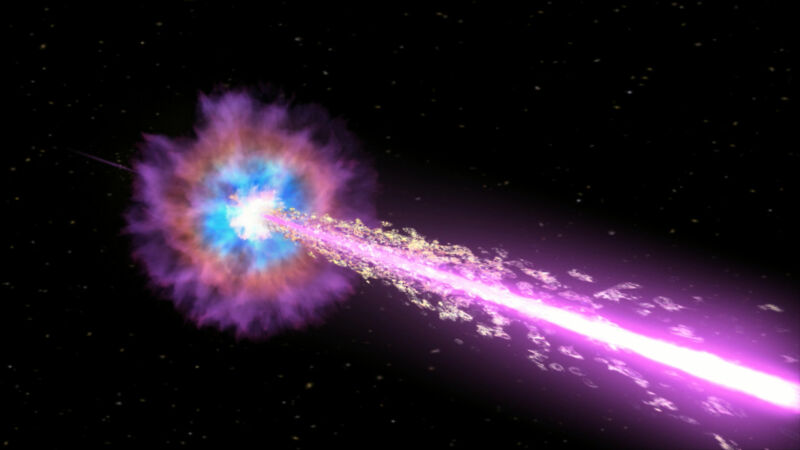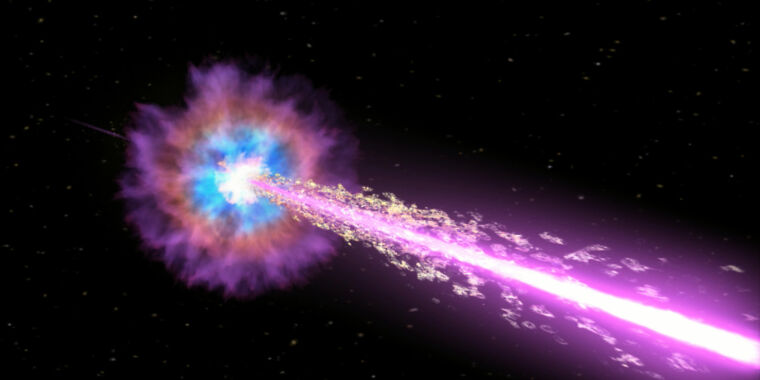
Supernovae are some of the most energetic events in the universe. And a subset of that involves gamma-ray bursts, where much of the energy released comes from extremely high-energy photons. We think we know why that generally happens: the black hole left behind the explosion is ejecting jets of material at almost the speed of light. But the details of how and where these jets produce photons are far from being fully worked out.
Unfortunately, these events happen very quickly and very far away, so getting detailed observations of them is not easy. However, a recent gamma-ray burst dubbed the BOAT (brightest of all time) may provide us with new information about the events within a few days of a supernova explosion. A new paper describes data from a telescope that happened to point both in the right direction and was sensitive to the extremely high-energy radiation produced by the event.
i need to shower
The “telescope” mentioned is the Large High Altitude Air Shower Observatory (LHAASO). Located nearly 4,400 meters above sea level, the observatory is a complex of instruments that are not telescopes in the traditional sense. Instead, they are intended to capture air showers — the complex cascade of debris and photons produced when high-energy particles from space slam into the atmosphere.
Although limited compared to traditional telescopes, air shower detectors have some advantages regarding events such as the BOAT. They have a very wide field of view, because they don’t have to focus so much on an event as to reconstruct it from the photons and particles that reach the Earth’s surface. And they’re only sensitive to high-energy events, meaning daylight has too little energy to interfere, so they can work around the clock.
Because LHAASO was collecting data when the BOAT supernova erupted, the detectors not only captured the onset of the event, but were able to track its evolution for days afterwards. Although there was poor spatial resolution, there was a huge amount of data, all separated by wavelength. In the first 100 minutes, more than 64,000 photons were detected at energies in excess of 200 giga-electron volts. For context, converting the full mass of a proton into energy would yield just under one GeV.
One of the first things that became apparent was that there was a big difference between the photons at lower (but still very high!) energies and those at the more extreme ends of the electromagnetic spectrum. Data from photons above a tera-electron volt gradually changed over time, while those in the mega-electron volt range fluctuated up and down.
Understand the data
That data, the researchers suggest, is consistent with the suggestion that the lower-energy events are caused by the jets interacting with the supernova’s turbulent debris. Since that debris will be both complex and close to the source of the jets, it will limit the amount of space particles in the jets to build up speed, putting a limit on their energy.
The higher-energy photons, on the other hand, are produced in regions where the jets have cleared away the supernova’s debris and are beginning to interact with the material that made up the environment around the star — likely particles flung away by the stellar equivalent of the solar wind. It’s a more sparse and consistent environment, giving the jets a less turbulent path to accelerate particles to the extreme energies needed to produce photons with energies above a TeV.
While it may seem difficult to outshine supernova debris, the process is extremely fast because the jets accelerate particles to near the speed of light. So it only takes about five seconds to see a rapid rise in TeV photons in the data.
From there there is a gentler incline that takes about 13 seconds. The research team behind the work suggests that the jets interact with and accelerate the particles in the environment beyond the star’s remnants. This increases the number of high-energy photons, but at the same time sucks some of the energy away from the jets as they push against an increasingly larger pile of material as they get further into the environment.
Eventually, that accumulation of material extracts so much energy that the number of high-energy photons gradually begins to decrease. This drop is slow enough that it takes about 11 minutes.
In the case of the BOAT supernova, this was followed by a sharp drop in high-energy photons. This is believed to be due to the jets dilating as they get further from their source and implies that the BOAT was as bright as we observed it because its jet’s central core was aimed directly at Earth. The timing of this drop-off also gives some information about how wide the jet was at the time.
Much remains to be learned about these events – for example, we remain uncertain about how black holes launch jets of material in the first place. But this kind of detailed observation can give us a better idea of the timing and dynamics of jet formation, which will ultimately help inform models about what happens during black hole formation and jet production.
Science, 2023. DOI: 10.1126/science.adg9328 (About DOIs).

